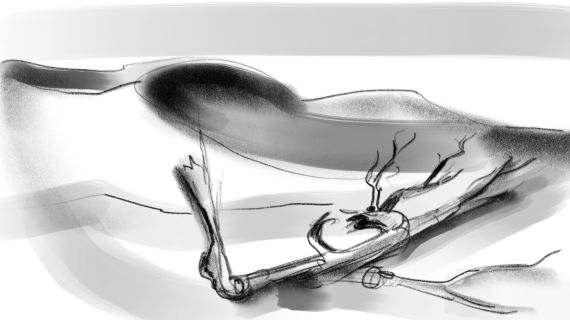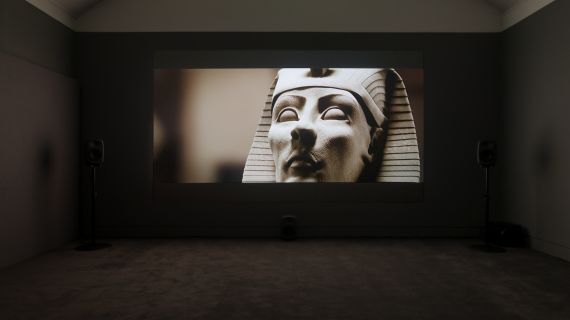
Storyboard artwork by Paul Donnellon at voodoodog.com
Single channel HD video, 22 minutes, 14 seconds, 2017
When the film-set for Cecil B DeMille’s The Ten Commandments had had its day, it was, like the biblical civilisation it evoked, lost to the sands of time - in its case, deliberately buried, in an act of money-saving expediency, under the dunes of the Southern California desert where the movie was shot. Over the years, though, those shifting sands have gradually exposed this piece of epic landfill, bringing souvenir hunters to gather where archaeologists (or Egyptologists) used to tread.
In Patrick Hough’s video, shot on location at the site, it is not just fake fragments of the past that are disinterred. What hovers over the place is a spirit of uncertainty; one that questions bedrock values like ‘originality’ and ‘authenticity’ and dusts them with other layers of meaning: the extraordinary ease of reproducibility, the spray-on glamour of cinematic semi-celebrity. This spirit of uncertainty is encapsulated by the figure of a sphinx - once part of the décor of the majestic film-set, now wandering in ghostly limbo; haunting the nearby town like a wildcat on the prowl. The sphinx’s hybrid form and cryptic, enigmatic presence is also a symbol of a blurring between the material and the virtual that Hough’s video not only proposes but visibly enacts, using sophisticated digital scanning techniques to suggest the outline of a new technological horizon that is, even as we look back nostalgically at the remnants of earlier eras, writing its own name upon the sand.
And If In A Thousand Years
False Starts at Solstice Arts Centre, Navan, Ireland
18 September 2018 - 26 October 2018
And If In A Thousand Years
6th Moscow International Biennale for Young Art
8 June 2018 - 31 July 2018
And If In A Thousand Years
Artists’ Film International: Patrick Hough, John Skoog, Ørjan Amundsen. Whitechapel Gallery, London
30 January 2018 - 1 April 2018
Jerwood/FVU Awards 2017: Neither One Thing or Another
22 March 2017 - 14 May 2017
Jerwood/FVU Awards 2017: Neither One Thing or Another
28 March 2017 - 28 March 2017
Jerwood/FVU Awards: Neither One Thing or Another and Borrowed Time
17 May 2017 - 17 May 2017
Jerwood/FVU Awards 2017: Neither One Thing or Another
8 November 2017 - 8 November 2017
Patrick Hough and Lawrence Lek: screening of previous film works
10 April 2017 - 10 April 2017
Jerwood/FVU Awards 2017: Neither One Thing or Another
6 June 2017 - 6 June 2017
And If In A Thousand Years
Moscow International Experimental Film Festival
23 July 2017 - 23 July 2017

Storyboard artwork by Paul Donnellon at voodoodog.com

Photographer: Anna Arca